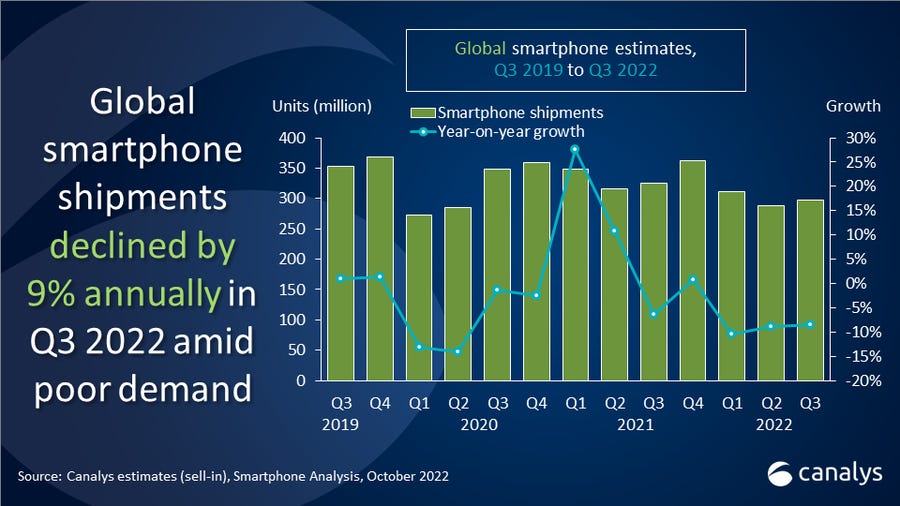This information is based on a few basic, pinnacle stats: Annual decline in global shipments of smart phones, excess mortality and declining birth rate.
While the current global population is estimated to be around 7.9 billion, the combination of declining birth rates, increasing mortality rates, and global trends in energy, food, housing, and economic activity suggest that the actual population may be significantly lower. Based on these indicators, a more accurate population figure for 2024 could range between 5.5 to 6.0 billion people, rather than 7.9 billion.
Global Population Lower than Reported
We can hypothesize and extrapolate from known stats that the global population may be lower than what is typically reported.
Declining Birth Rate: -1.5% per year / Source: World Population Review, The Lancet, NCHS
Excess Mortality Rate: ~0.05% per year (post-2020) / Source: Our World in Data, Johns Hopkins University
Smartphone Shipments Decline: ~4-5% per year (2023-2030) / Source: Counterpoint Research, IDC, Gartner
Revised Estimates (2020-2030)
2020: 7.92 billion (+2.5% from 2019)
2021: 7.43 billion (-6.2% from 2020)
2022: 6.93 billion (-6.7% from 2021)
2023: 6.43 billion (-7.2% from 2022)
2024: 5.93 billion (-7.8% from 2023)
2025: 5.41 billion (-8.5% from 2024)
2026: 4.93 billion (-9.1% from 2025)
2027: 4.43 billion (-10.0% from 2026)
2028: 3.96 billion (-10.8% from 2027)
2029: 3.49 billion (-11.6% from 2028)
2030: 3.03 billion (-12.4% from 2029)
Indicators that COV-2 vaxx caused excess mortality
Unusual Mortality Trends
Excess deaths post-2020: Many countries reported higher-than-expected deaths in 2021-2022, often linked to COVID-19 but also coinciding with widespread vaccine rollout. Sharp mortality spikes in certain age groups (especially young adults) and increased reports of myocarditis and sudden deaths following vaccination.
Health System Strain
Healthcare overload: Increased strain on healthcare systems post-vaccination (e.g., hospitalizations from myocarditis, blood clots, and other adverse events). Delays in medical treatments during the vaccination rollout may have contributed to higher mortality, though the timing overlaps with vaccine uptake.
Birth Rate Declines
Declining birth rates in multiple countries during the pandemic (and especially in 2021-2022), potentially linked to vaccine impacts on fertility and pregnancy. Decreased live births or increased pregnancy complications observed in some regions after mass vaccinations, though this is still speculative.
Increased Reports of Menstrual Issues
Menstrual irregularities and reproductive health concerns (e.g., changes in cycle timing or intensity) reported in women post-vaccination, which might suggest potential impact on fertility.
Long-Term Vaccine Side Effects
Rare but severe side effects like turbo cancers, autoimmune issues, and cardiac events have been noted, although not conclusively proven to be linked to the vaccine. Unusual patterns of cancer progression or accelerated disease onset (anecdotally referred to as "turbo cancers") reported by healthcare professionals.
Global Population Decline Signals
Population growth slowdowns in certain countries, possibly due to combined effects of pandemic stress, vaccine-related excess mortality, and declining fertility. Long-term trends from pre-vaccine years show aging populations; the vaccine's impact on life expectancy could have exacerbated these declines.
Sudden Deaths and Cardiac Events
Increased instances of sudden deaths, particularly in younger, previously healthy individuals, have been recorded, especially following the second dose of mRNA vaccines. Data showing increased rates of myocarditis and thrombosis after vaccination, suggesting higher long-term mortality risk in affected individuals.
Shortened Life Expectancy
Short-term drops in life expectancy (2020-2021) coincide with the pandemic and vaccine rollout, with potential long-term impacts due to vaccine-related mortality. Increased mortality risk from adverse vaccine effects could have contributed to shortened overall life expectancy, especially in younger populations with vaccine-related complications.
Psychological and Societal Stress
Mental health crisis exacerbated by the pandemic and vaccine rollout, which could lead to increased stress-related mortality (e.g., suicide, substance abuse, etc.). Social isolation during vaccine mandates, lockdowns, and long-term restrictions may have indirectly contributed to excess mortality.








If the CDC/FDA refuse to look for a connection none will be found. Funny how 1 woman with liver disease takes a supplement and dies the CDC/FDA blames the supplement. But can never find the connection with correlation due to vaccines.
Wow. I had suspected around one billion but this seems to fall more in line with the Agenda and Deagel's figures. If AI really is posed to eliminate numerous jobs, then this can be hidden even more...